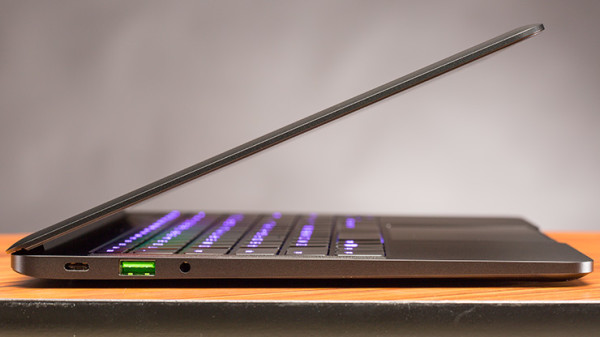Design
With the exception of screen resolution, the design of the Stealth (QHD) is identical to its more expensive brother, the Razer Blade Stealth (4K UHD), in every way. The higher price of the 4K model bumps it into the high-end ultraportable category, while the QHD configuration is midrange, giving this system a different field of competitors. The lower 2,560-by-1,440-resolution screen is not quite as bright or vibrant as the 4K model’s 3,840-by-2,160 display, but it’s still impressive, and the resolution is more than enough for the 12.5-inch panel. For comparison, the MacBook Air’s 1,440-by-900 resolution (below 1080p) is much lower. The drop from 4K to QHD actually brings a performance boost, since the Stealth (QHD)’s screen is less demanding on the rest of the hardware. This was reflected in its performance numbers in testing (more on that later), which are a bit faster overall, and the Stealth (QHD)’s battery lasted about an hour longer.
The unique RGB keyboard with per-key backlighting, included on both Razer Blade Stealth models, is a fun and easy-to-use feature. You can set colors and lighting effects for individual keys or whole sections of the keyboard, and the free software makes customization simple. No notebook has offered individual key backlighting before; this level of customization is usually reserved for premium, standalone USB gaming keyboards.
Like the 4K version, the Stealth (QHD) is powered and charged via a USB-C port with Thunderbolt 3, which offers speeds of up to 40Gbps. The left side of the laptop also includes a USB 3.0 port and the headset jack. On the right, there’s another USB 3.0 port and an HDMI port. The MacBook Air also includes two USB 3.0 ports, and it does have an SDXC slot, unlike the Stealth (QHD), but it only features a Thunderbolt 2 port, and lacks an HDMI port. For more on the Stealth (QHD)’s design, including a deeper analysis of the keyboard, touchpad, speakers, ports, and general build, as well as a description of the Razer Core, read our Razer Blade Stealth (4K UHD) review.
Performance
The Stealth (QHD) includes the same internal components as the 4K model—a 2.5GHz Intel Core i7-6500U processor, 8GB of memory, and integrated Intel HD Graphics 520—but its lower-resolution screen led to better performance. Since the QHD system falls into midrange pricing, there’s also a different set of comparison laptops. The Stealth (QHD) scored 2,764 points in the PCMark 8 Work Conventional productivity test, a score that beats other midrange ultraportables like the Asus ZenBook UX305CA$678.79 at Amazon (2,496 points) and the Asus UX305FA-ASM1 (2,257 points). Midrange convertible-hybrid laptops like the Toshiba Satellite Radius 12 (P20W-CST3N01)$1,099.99 at Toshiba Direct (2,921 points) and the Dell Inspiron 13 7000 Series 2-in-1 Special Edition$999.99 at Dell (2,870 points) scored slightly higher, but all four of these other systems are only powering much-less-taxing 1080p displays.
On the 3DMark Cloud Gate and Fire Strike Extreme tests, the Stealth (QHD) scored an excellent 5,795 and 391 points, respectively. The Asus UX305CA (4,415 points) and the Asus Zenbook UX305FA-ASM1$649.99 at Amazon (4,270 points) came up short in comparison, while the Toshiba Radius 12 (5,736) came very close. Like the Razer Stealth (4K UHD) and other ultraportables, the Stealth (QHD) isn’t equipped for serious gaming, due to its integrated graphics. On the Heaven and Valley gaming tests at Medium-quality settings, it scored 19 frames per second (fps) and 23fps, respectively, which is equal to or a few frames better than the other systems. We consider 30fps as smooth enough for gameplay, however, and the Stealth (QHD)’s frame rates on the Heaven and Valley tests at Ultra-quality settings topped out at 2fps, so as with all of these laptops, I suggest you stick to less-demanding games on lower settings.
In our multimedia tests, the Stealth (QHD) also posted top results. It finished the Handbrake video-encoding test in 2 minutes 16 seconds, the Photoshop test in 4:36, and it scored 316 on CineBench. The Asus UX305CA was behind on all accounts, as was the 13-inch MacBook Air. Even the Apple MacBook Pro 13-Inch, Retina Display$994.50 at ebay, a high-end ultraportable, was slightly slower overall, scoring 2:38 on Handbrake, 4:17 on Photoshop, and 311 on CineBench. The Stealth (QHD) is an all-around fast performer for work and media projects, even with its small size and QHD display.
Battery life is decent, with the laptop lasting 7 hours 36 minutes on our rundown test. While that’s pretty good compared with desktop-replacement or gaming laptops, battery life is especially important for ultraportables, since they’re mainly travel companions. The 13-inch MacBook Air still dominates, lasting 17:36 on the rundown test (though it has a 1,440-by-900-resolution display). Other systems, such as the Asus UX305CA (8:30), the similarly pricedGoogle Chromebook Pixel (12:00), and the 13-inch MacBook Pro (11:10) all lasted longer, due at least in part to the Stealth’s QHD display draining the battery faster.
Conclusion
The Razer Blade Stealth (QHD) features fast performance and a top-notch display packed into a premium, compact body. Though it isn’t capable of serving as a dedicated gaming laptop without the Razer Core, it’s an excellent ultraportable in its own right. It’s a less-expensive alternative to the Razer Stealth (4K UHD), with a longer battery life and better performance, thanks to its less-power-hungry display. The 13-inch Apple MacBook Air has a longer-lasting battery, but the Stealth (QHD) has a superior screen with touch functionality, along with better gaming features and faster performance, making it our new Editors’ Choice for midrange ultraportables.
 Yaspan Tech, Computers, Gadgets, Reviews, News and Analysis
Yaspan Tech, Computers, Gadgets, Reviews, News and Analysis






